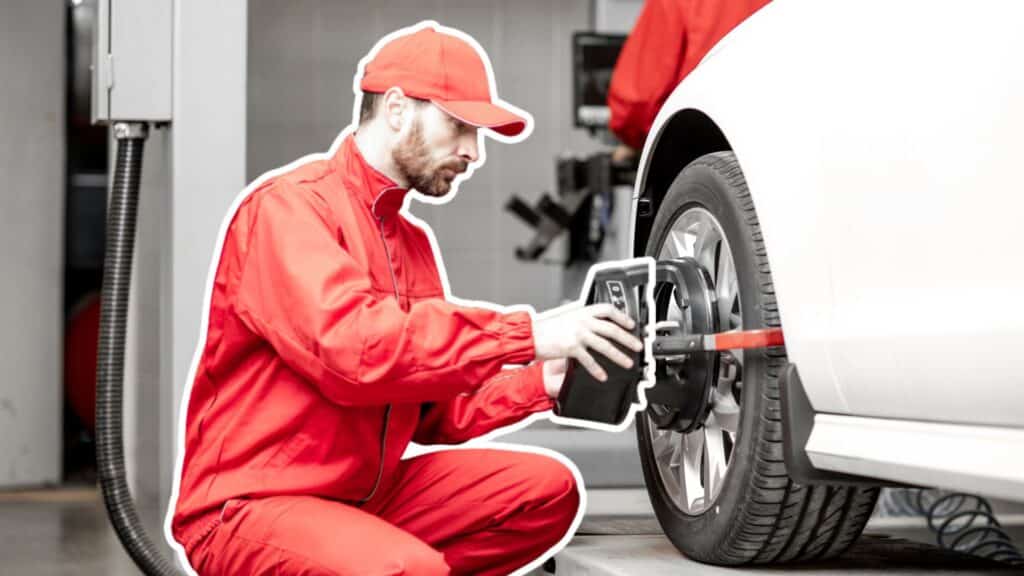Many drivers wonder when should you get a wheel alignment, but misconceptions often cloud this crucial aspect of car maintenance.
You might think alignment is only necessary after hitting a pothole or when your car visibly pulls to one side.
Truthfully, wheel alignment needs are more subtle and frequent than most people realize.
This post will clear up common misunderstandings about wheel alignment, helping you make informed decisions about your vehicle’s care.
We’ll explore the signs that indicate it’s time for an alignment check, the impact of proper alignment on your car’s performance and safety, and how often you should schedule this vital service.
By the end, you’ll have a clear roadmap for maintaining optimal wheel alignment, ensuring a smoother, safer ride, and extending the life of your tires.
When Should You Get a Wheel Alignment?
Knowing the right time for a wheel alignment can save you money and keep your car running smoothly.
Generally, experts suggest getting an alignment every 6 months or 6,000 miles as part of routine maintenance.
However, certain events might call for an earlier check. If you’ve been in a collision or hit a large pothole or curb, it’s wise to have your alignment inspected.
Keep an eye out for visible signs too. Uneven tire wear, your car pulling to one side while driving, or feeling vibrations in your steering wheel are all red flags.
These symptoms indicate it’s time to visit a mechanic for an alignment check, even if you haven’t reached the 6-month or 6,000-mile mark.
Debunking Common Myths
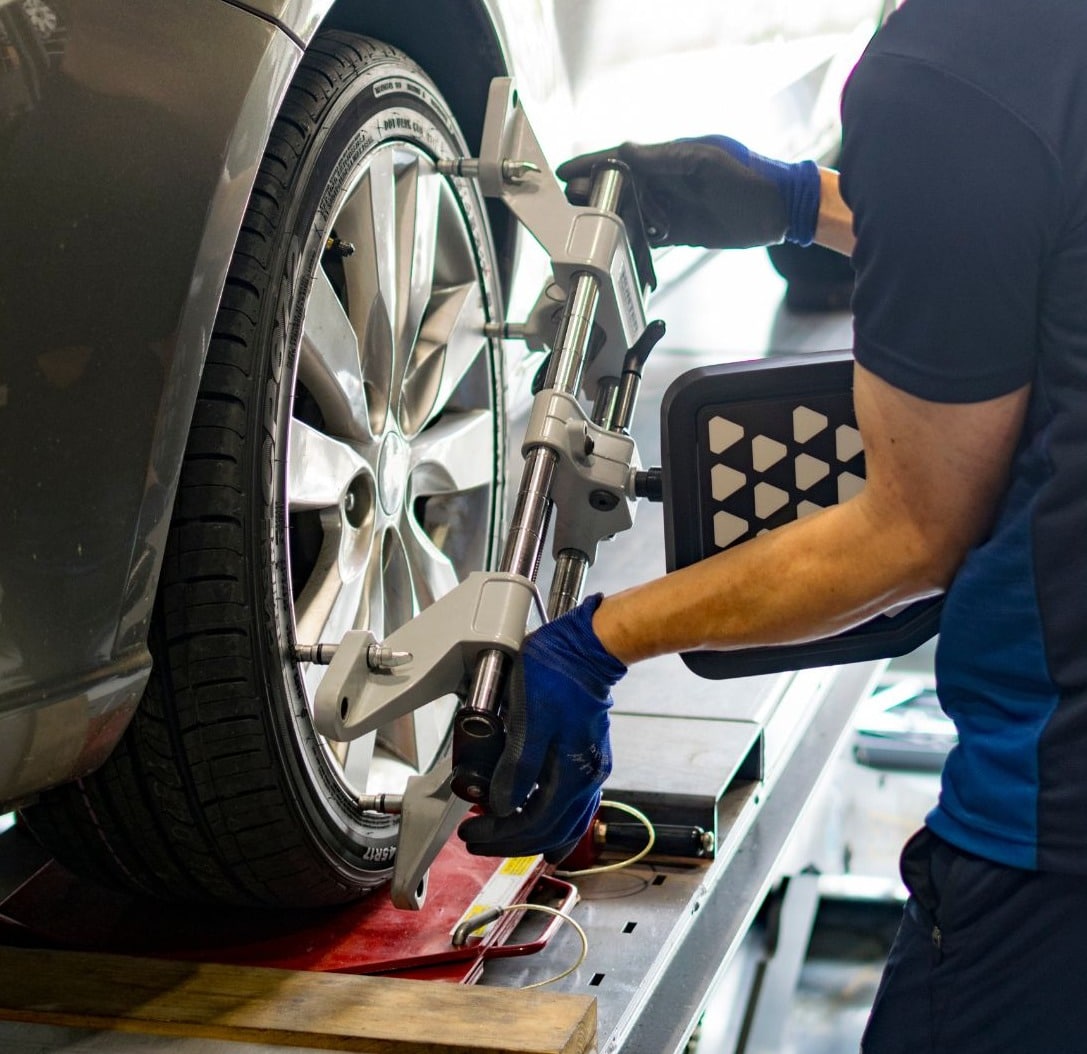
Misconceptions about wheel alignment can lead to costly mistakes. Let’s set the record straight on some common myths that might be affecting your vehicle maintenance decisions.
Myth 1: Wheel Alignment Only Needs Attention After Hitting a Pothole
While potholes can certainly affect alignment, everyday wear and tear is often the culprit. Regular driving, even on smooth roads, can gradually misalign your wheels.
Ignoring these small changes can lead to uneven tire wear and reduced fuel efficiency over time. It’s best to check alignment regularly, not just after obvious impacts.
Myth 2: I Can Align My Wheels Myself at Home
Wheel alignment requires specialized equipment and expert knowledge. It’s not a DIY job.
Attempting to align your wheels at home can actually worsen existing issues and create safety risks. Trust this task to professionals who have the right tools and training to do it correctly.
Myth 3: Regular Tyre Rotations Eliminate the Need for Alignment
Tyre rotations are important, but they don’t replace the need for alignments. Rotations help distribute wear evenly across your tires, but they don’t correct the angles of your wheels.
For optimal tire health and vehicle performance, complement your regular rotations with professional alignments.
Myth 4: Wheel Alignment is Expensive and Unnecessary
Far from being unnecessary, regular alignments can save you money in the long run. They prevent costly repairs, extend tire life, and improve fuel efficiency.
When you consider the potential expenses of premature tire replacements or suspension damage, alignment checks are a cost-effective investment in your vehicle’s health.
Myth 5: My Car Will Tell Me When It Needs an Alignment
While some alignment issues produce noticeable symptoms, others can be subtle. Waiting for obvious signs might mean you’ve already experienced unnecessary wear and tear.
Taking a bold approach with regular alignment checks can catch and correct issues before they become serious problems, ensuring your safety and saving you money.
Importance of Regular Wheel Alignment
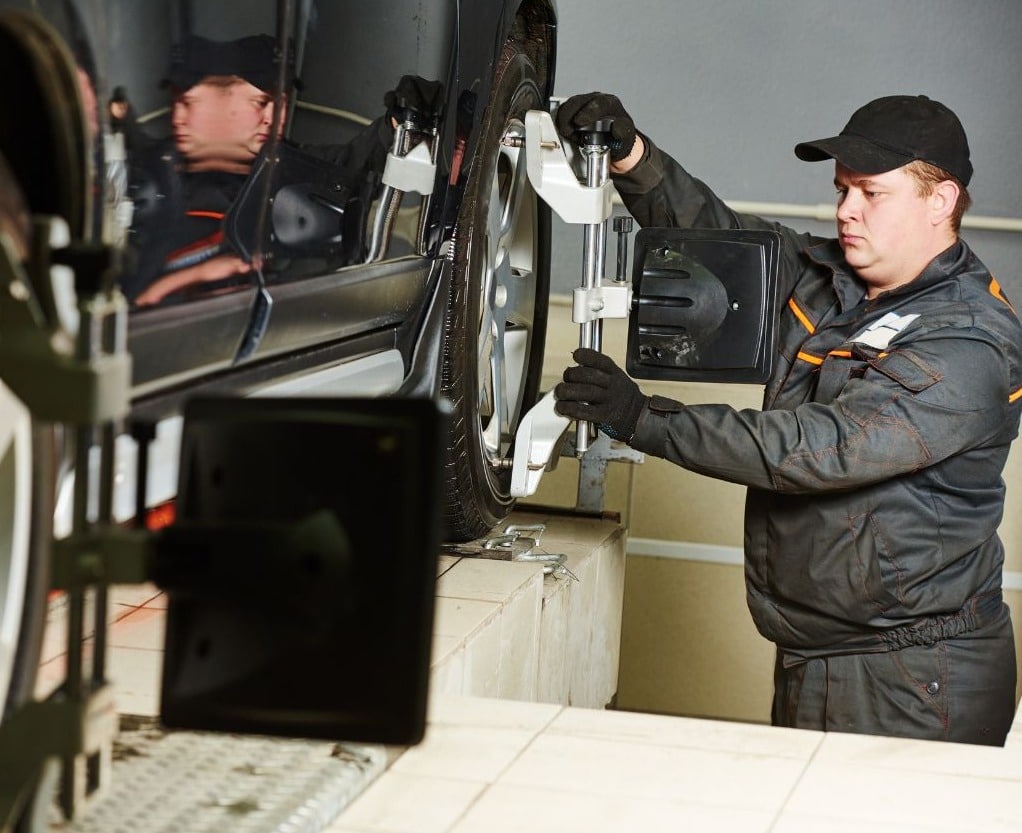
Understanding when you should get a wheel alignment is crucial, but knowing why it’s important can motivate you to stay on top of this vital maintenance task.
Let’s explore the key benefits of keeping your wheels properly aligned.
1. Improved Handling and Steering
Regular wheel alignments enhance your vehicle’s handling and steering. When your wheels are correctly aligned, your car responds more accurately to your steering inputs.
This improved control translates to better safety on the road, especially during emergency plots or when driving in bad weather conditions.
2. Extended Tire Life
Proper alignment ensures even tire wear across all four tires. When wheels are misaligned, certain areas of your tires bear more weight than others, leading to uneven wear patterns.
By maintaining correct alignment, you can significantly extend the life of your tires, saving you money on premature replacements.
3. Improved Fuel Efficiency
Believe it or not, wheel alignment affects your car’s fuel efficiency. Misaligned wheels create more rolling resistance, forcing your engine to work harder and use more fuel.
By keeping your wheels aligned, you reduce this resistance, improving your vehicle’s fuel economy and saving money at the pump.
4. Reduced Maintenance Costs
Regular alignments can prevent damage to your car’s suspension and steering components.
When wheels are misaligned, it puts extra stress on these parts, potentially leading to premature wear and costly repairs.
By investing in regular alignments, you’re protecting these crucial systems and reducing your overall maintenance costs.
Signs That Your Vehicle Needs Wheel Alignment
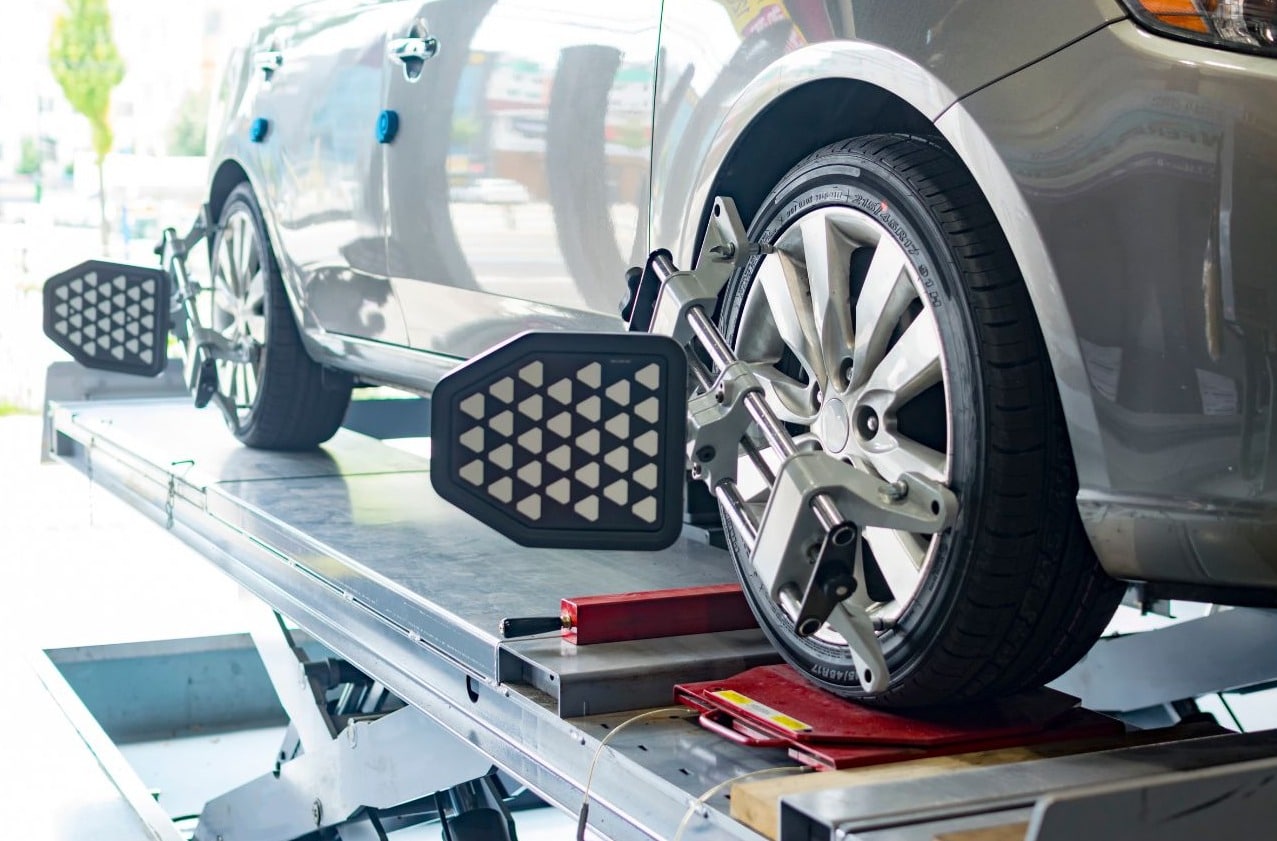
Knowing when you should get a wheel alignment isn’t always obvious, but your vehicle often provides clues.
Being aware of these signs can help you address alignment issues before they become more serious problems. Let’s look at some key indicators that it’s time for an alignment check.
- Uneven Tire Wear: Check your tires regularly. If you notice one side of a tire wearing faster than the other, it’s often a sign of misalignment. This uneven wear can shorten your tires’ lifespan and affect your vehicle’s performance.
- Vehicle Pulls to One Side: If your car drifts left or right when driving on a straight, level road, it likely needs an alignment. This pulling can be subtle, so pay attention to whether you’re constantly correcting your steering.
- Steering Wheel Vibrations: Unusual vibrations in your steering wheel, especially at higher speeds, can indicate alignment problems. These vibrations occur because your tires aren’t moving in the same direction.
- Squealing Tires: When your wheels are misaligned, it can cause your tires to drag or slip slightly as you drive. This can result in a squealing noise, particularly when turning.
- Crooked Steering Wheel: If your steering wheel isn’t centered when driving straight, it’s a clear sign of misalignment. This off-center position indicates that your wheels and steering system aren’t properly aligned.
Types of Wheel Alignment Services

When considering when you should get a wheel alignment, it’s helpful to understand the different types of services available.
Each type addresses specific alignment needs, ensuring your vehicle gets the right care. Let’s explore the main types of wheel alignment services.
- Front End Alignment: This service focuses on adjusting only the front wheels. It’s suitable for vehicles with a solid rear axle and is often enough for cars that have been in minor accidents or hit curbs.
- Four-Wheel Alignment: As the name suggests, this service aligns all four wheels. It’s ideal for vehicles with independent rear suspensions and ensures that all wheels are perpendicular to the ground and parallel to each other.
- Thrust Alignment: This type of alignment ensures that the rear wheels are parallel to the front wheels. It’s particularly useful for vehicles with a misaligned rear axle that causes the car to “crab walk” or move at a slight angle.
- Camber and Caster Alignment: This service adjusts specific angles of the wheels. Camber alignment corrects the inward or outward tilt of the wheels, while caster alignment adjusts the angle of the steering axis. These alignments can significantly impact your vehicle’s handling and tire wear.
What to Expect During a Wheel Alignment Appointment?
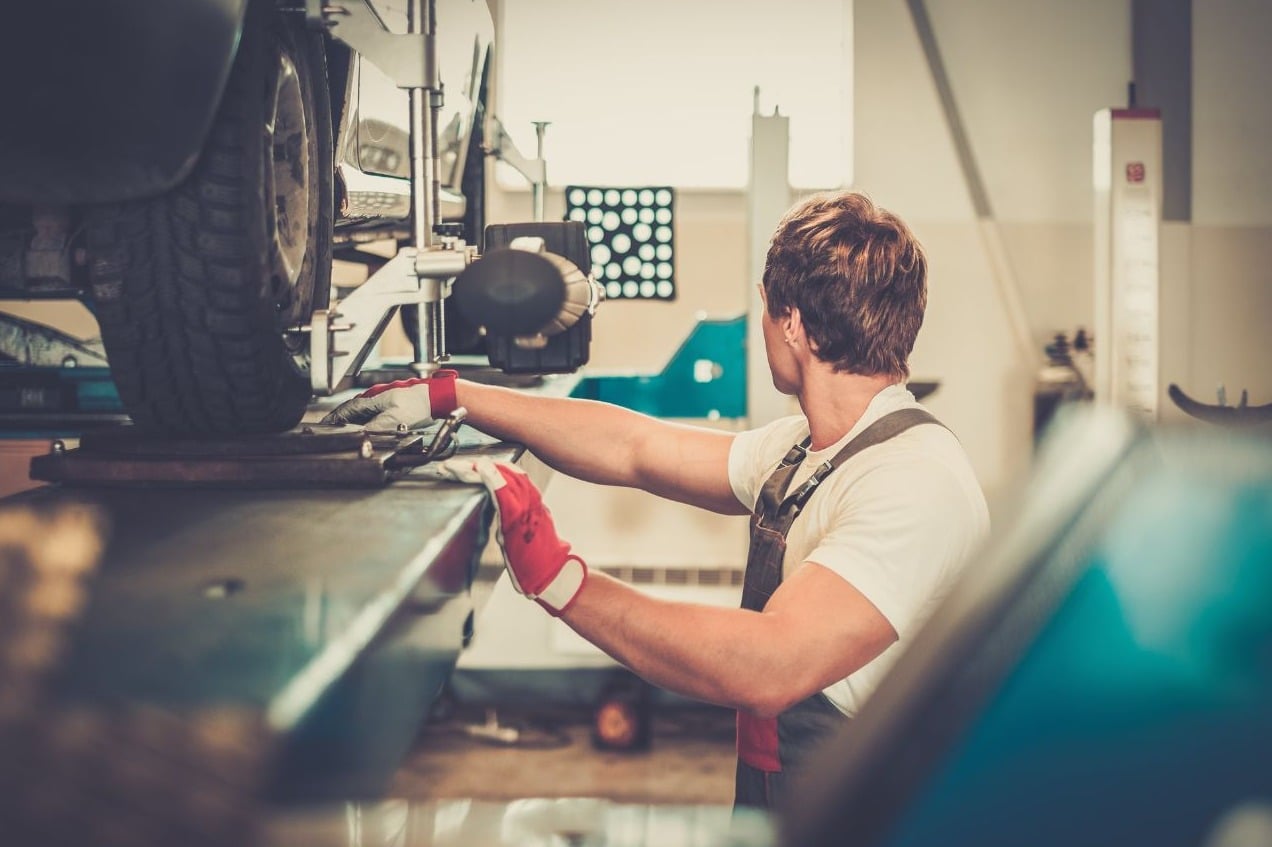
Understanding the process can help you know when you should get a wheel alignment and what happens during the service.
Here’s a brief overview of what typically occurs during an alignment appointment.
- Initial Inspection: The technician starts by examining your vehicle’s tires, suspension, and steering components. This check helps identify any issues that might affect the alignment process or require attention before alignment can begin.
- Alignment Process: Using specialized equipment, the technician adjusts the angles of your wheels to match the manufacturer’s specifications. This precise process ensures your wheels are properly aligned for optimal performance and safety.
- Test Drive: After the adjustments, the technician usually takes your vehicle for a short test drive. This step confirms that the alignment is correct and that your car handles properly on the road.
- Results and Recommendations: You’ll receive a report showing the before and after measurements of your vehicle’s alignment angles. The technician may also provide recommendations for maintaining your alignment, such as regular tire rotations or suspension checks.
Conclusion
Knowing when you should get a wheel alignment is crucial for your vehicle’s health and your safety on the road.
Regular alignments, typically every 6,000 miles or 6 months, can prevent many issues before they start.
However, don’t wait for these intervals if you notice signs like uneven tire wear or your car pulling to one side.
When should you get a wheel alignment? Remember, it isn’t just about fixing problems—it’s about maintaining your car’s performance, extending tire life, and ensuring fuel efficiency.
By debunking common myths and understanding the importance of proper alignment, you’re now equipped to make informed decisions about your vehicle’s care.
Don’t hesitate to consult a professional if you’re unsure when you should get a wheel alignment. Your car—and your wallet—will thank you for staying proactive about wheel alignment.
Frequently Asked Questions
1. How do you know if you need an alignment?
Signs include uneven tire wear, your vehicle pulling to one side, a tilted steering wheel when driving straight, and vibrations in the steering wheel. Regular checks every 6,000 miles are also recommended.
2. Is it a must to get a wheel alignment?
While not mandatory, regular wheel alignments are crucial for vehicle safety, performance, and longevity.
They prevent uneven tire wear, improve fuel efficiency, and ensure better handling on the road.
3. Is wheel alignment worth it?
Yes, wheel alignment is worth the investment. It extends tire life, improves fuel efficiency, ensures safer driving, and prevents costly repairs to your suspension system. The benefits far outweigh the cost of the service.
4. How many miles does a wheel alignment last?
A wheel alignment typically lasts about 6,000 miles or 6 months, whichever comes first.
However, this can vary based on driving conditions, vehicle type, and whether you’ve hit any potholes or curbs.


